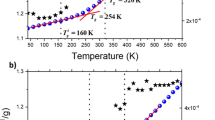Abstract:
Freely standing polystyrene films show an anomalous drop of the glass temperature when the molecular weight is high and the thickness smaller than the coil size R0. We present here a tentative explanation for these features, where two types of motions compete: a) standard motions, controlled by the free volume, and independent of chain length, b) collective motions along the chain, which require a weaker free volume (except for the end groups). For bulk systems, the standard motion always wins because of the end group hindrance. But for films thinner than the coil size, the dominant process may be the collective motion of a “loop” which does not involve the chain ends. What matters then is not the overall polymerisation index (N), but the length g of a typical loop starting from the surface (which is a more fluid region) and reaching deep into the film. With these ingredients, some surprising aspects of may possibly be understood.
Similar content being viewed by others
Author information
Authors and Affiliations
Additional information
Received 7 December 1999
Rights and permissions
About this article
Cite this article
de Gennes, P. Glass transitions in thin polymer films. Eur. Phys. J. E 2, 201–205 (2000). https://doi.org/10.1007/PL00013665
Issue Date:
DOI: https://doi.org/10.1007/PL00013665




